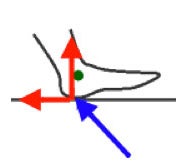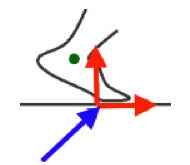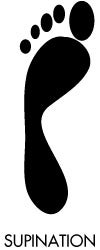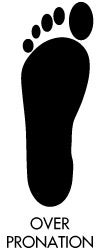LEARNING CENTER: HOW TO
Foot Motion Characteristics
Running is a form of human locomotion that involves cyclic movement of the legs and includes a period of time when neither foot is in contact with the ground. The gait cycle is used to describe this cyclic movement.
Gait cycle
The gait cycle consists of two movement periods: swing and stance. The swing period is the movement of one leg while its foot is in the air. The stance period is the period of movement of the leg and foot while the foot is in contact with the ground. The stance period may be divided into the following three phases:

Impact (heel-strike) Phase:
The impact phase is initiated when the foot makes contact with the running surface. Forces of two to three times the runners body weight is imparted to the body during the impact phase.

Support (mid-stance) Phase:
The support phase consists of the foot supporting the body as the foot transitions from heel to toe. A controlled elongation of the arch of the foot maintains proper support and allows for neutral pronation. Too much elongation of the arch will tend to result in over-pronation while limited elongation of the arch will tend to result in supination.

Propulsion (toe-off) Phase:
Forces are distributed across the forefoot and the arch stiffens as the foot prepares to leave the ground.
Foot-strike
A foot-strike characterizes the movement of the foot as it goes through the three phases of stance: impact, support and propulsion.
The human body is an amazing mechanical specimen when functioning correctly. Unfortunately weaknesses and imbalances within individuals often subject the running body to forces and motions that lead to injury. An imperfection of the body may be exhibited in the feet during running and walking. Ideally a foot should contact the ground and roll slightly outward before rolling slightly inward. Before the foot leaves the ground, it should roll slightly outward again. Collectively, these slight movements allow the foot to function correctly in absorbing or dissipating ground forces and are said to result in a neutral foot-strike. Too much or too little movement usually leads to problems. See below to learn about the three common foot-strikes.
Supination:
Supination is the lack of an inward roll or a rolling out of the foot during its foot-strike. This motion inhibits the footÉs ability to absorb ground forces. Also referred to as under-pronation, a foot that supinates needs a soft ride and quick heel-to-toe transition. Also, excellent flexibility in a shoe is desirable. Minimum neutral shoes and moderate neutral shoes work well for supination.
Pronation:
Neutral pronation is the slight inward rolling movement of the foot during its foot-strike. Neutral pronation is considered to be the ideal motion of the foot during running and walking and greatly reduces the risk for injury. People with neutral pronation tend to find success in neutral shoes or mild support shoes.
Over-pronation:
Over-pronation is excessive inward rolling (pronation) of the foot during its foot-strike and often creates alignment problems within the legs. There is a wide range of degrees of over-pronation. Minimium support shoes, moderate support shoes and maximum support shoes are designed for feet, which need some guidance to steer the foot along a path of neutral pronation. Moderate motion control shoes and maximum motion control shoes are designed for the most excessive degrees of over-pronation and work to control the motion of the foot.
What's the Outsole?
Typically made of rubber, the outsole is the bottom of the shoe. The outsole provides traction and contributes to how soft or firm the shoe "rides" as well as the torsion rigidity and flexibility.
- Carbon Rubber - Durable rubber compound that makes up the majority of running shoe outsoles.
- Blown Rubber - Air-injected rubber that is lighter, softer and more flexible than traditional rubber. Blown rubber is most often found in the forefoot. It provides a great feel but is less durable than carbon rubber.
- Shape - Outsoles range in shape from curved to straight. Curved shoes tend to be less stable, and are best for neutral runners to supinators, while more rigid straight shoes are best for overpronators.
How to determine your foot motion
If you do not know what type of motion your feet have and do not have the opportunity to have your foot motion evaluated by another person, use the following information to estimate your foot motion.
Midsole Creasing
The best indirect measure of foot motion is the wear of the midsole, which is indicated by creasing in the midsole EVA foam. Note that a shoe with a polyurethane midsole will not show creasing. Fortunately, most running shoes are made with EVA foam midsoles. As a midsole breaks down creases will develop. A greater number of stacked creases or deeper creases indicate greater wear. Old shoes will display creases without applying a load while shoes with less mileage will need to be compressed with your hands. A neutral foot-strike will create creasing in the lateral heel of the midsole and medial forefoot of the midsole. Excessive creasing of the midsole in the lateral midfoot suggests that supination is occurring. Excessive creasing in any part of the medial side of the midsole from the heel to just before the forefoot suggests that the foot is experiencing over-pronation.
Outsole Wear-pattern
A fair measure of foot motion is outsole wear. The pattern of wear on the outsole may represent how forces are distributed along the shoe during stance. Compare the wear pattern from your shoe with the images below.
Footprint
A wet footprint test is a common method for determining foot motion. Get your feet wet and stand on a flat surface that will allow your footprint to be shown. A paper towel works well. Compare your footprint to the images below.



One problem with the footprint test is that it is a static measure and feet have dynamic movements during stance while running. To make the footprint test better, compare seated (non weight-bearing) footprints with standing (weight-bearing) footprints. If the standing footprint has a greater surface area than the seated footprint then you probably need some pronation control. Another problem with the footprint test is that some people have footprints that match the above images but their feet do not move in the indicated way.
Arch Height
Although the relationship does not always hold true, there is a tendency for foot motion to be associated with arch height. Generally, the higher the arch the less the foot will pronate and the lower the arch the more the foot will pronate. Either stand on a hard surface and view the medial side of your foot in a mirror or take a picture of your foot and compare it to the images below.

Arch height works best as an indicator of foot motion for people at the extremes. However, there are people with high arches that over-pronate and people with no arches that supinate.
Get your shoe size
Sizing may vary between shoe models, even from the same manufacture. The variation is due to the construction process of attaching the upper to the midsole (see Shoes PhD for more information).
Shoe Fit
A proper fitting shoe should be snug in the heel and fitted in the midfoot to keep the foot in place. Feet expand during a run and a proper fitting shoe should have room around the toes to allow for this expansion. It is better for a shoe to be too big than too small. Always fit the larger foot. See below to determine the proper size shoe for you.
True-to-size: A shoe that should fit according to the value obtained from a Brannock Device is said to fit true-to size.
Half-size small: A shoe that fits a half-size smaller than the value obtained from a Brannock Device. So if your foot is measured at a size 9, you will need to get a size 9.5.
Full-size small: A shoe that fits a full-size smaller than the value obtained from a Brannock Device. So if your foot is measured at a size 9, you will need a size 10.
Length: If you do not have access to a Brannock Device, do the following to determine your measured shoe size. Find a hard, flat floor. Place your heel against a wall and measure the length of your foot. The measurement may be done by standing on a piece of paper and making a mark at the longest toe or by using a nylon measuring tape and directly obtaining the length. Use the following chart to convert your measurement to a shoe size.
| Foot in inches | Foot in centimeters | US Women's Size | US Men's Size |
| 8 11/16 | 22.07 | 5 | - |
| 8 13/16 | 22.38 | 5.5 | - |
| 9 | 22.86 | 6 | - |
| 9 3/16 | 23.34 | 6.5 | - |
| 9 5/16 | 23.65 | 7 | 6 |
| 9 1/2 | 24.13 | 7.5 | 6.5 |
| 9 11/16 | 24.61 | 8 | 7 |
| 9 13/16 | 24.92 | 8.5 | 7.5 |
| 10 | 25.4 | 9 | 8 |
| 10 3/16 | 25.88 | 9.5 | 8.5 |
| 10 5/16 | 26.19 | 10 | 9 |
| 10 1/2 | 26.67 | 10.5 | 9.5 |
| 10 11/16 | 27.15 | 11 | 10 |
| 10 13/16 | 27.46 | 11.5 | 10.5 |
| 11 | 27.94 | 12 | 11 |
| 11 3/16 | 28.42 | - | 11.5 |
| 11 5/16 | 28.73 | 13 | 12 |
| 11 1/2 | 29.21 | - | 12.5 |
| 11 11/16 | 29.69 | - | 13 |
| 12 | 30.48 | - | 14 |
| 12 5/16 | 31.27 | - | 15 |
| 12 13/16 | 32.23 | - | 16 |
| 13 | 33.02 | - | 17 |